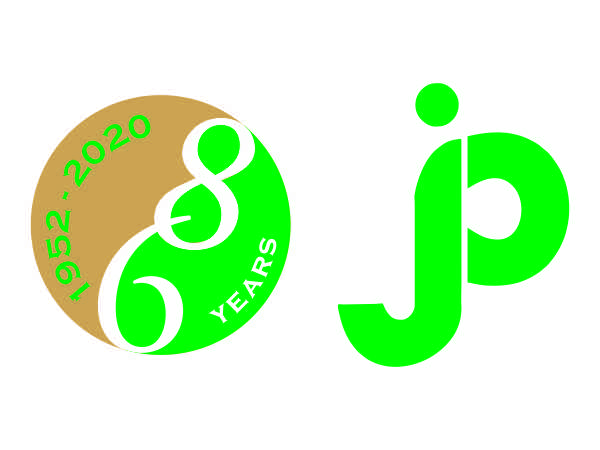Paper Making, Paper Sizes and Properties
PAPER MAKING HISTORY
Before year 105 A.D., man was not acquainted with the term 'Paper' and
till that time things were written on tree leaves, sand, bricks, clothe
etc. As early as 3500 B.C. the papyrus reeds of the Nile swamps served
Egyptians the purpose of sheet to inscribe their records. Around 170
B.C. animal parchment came in use in bordering Mediterranean countries.
The invention of paper was done by a Chinese scholar Tsai Lune in the year 105 A.D. He mashed the sodden bark and hemp into a pulp and pressed out the liquid. The pulp that remained was then hung to dry in the sun and resulting uneven, rough sheet was found to be better means of writing. That was the first sheet of paper produced.
This gave the idea that fibres are essence of paper. We cannot have paper in true sense unless it is made of infinitesimal fibres matted together.
With the advancement of knowledge necessity of communicating enhanced. It was only in the eighth century that paper-making spread to Middle East and thence to Western European countries.
Invention of paper making machine was the greatest ever milestone achieved in the history of paper-making. The first papermaking machine was result of experiments done by a group consisting of John Gamble, Henry & Sealy Four-drinier and an engineer Bryan Donkin of Donkin & Hall. Their first machine worked at Hertfordshire in 1803 and second at Two Waters in about 1805. In 1809, John Dickinson patented a cylinder machine which resulted in better working.
With the spread of learning and research work, paper making became a global industry. Modern paper is manufactured from a mixture of various fibres such as wood, bamboo, rag linen which are mixed with a large quantity of water. The mixture is then treated with sizing agent and other chemicals to give the desired properties to paper. The resulted preparation is called 'stuff', which is poured out over a moving screen of fine wire. This screen turning continuously on rollers move along rapidly under the flowing water, which quickly seeps through the screen, depositing wet fibres on it. The fibres cling to one another and mat together to form a large sheet like mass. As the screen moves along, it carries the water-soaked mass to huge rollers where with the help of felt, it is dried and passed over to couch roll and large heating rollers where it is pressed and dried. And finally, it emerges from the machine as a beautiful continuous sheet of paper, which is wound into a large roll at far end of the machine. This roll is also cut into sheets of various sizes. This briefly outlines the process of modern paper-making.
Paper - Its classification and uses
Paper is the common name
for the substance used for writing or printing upon or for packaging, and
wrapping as well as for many special purposes. Its specifications vary
according to the end use. Paper may broadly be classified into two
categories, namely,
(a) the products which are used for writing and printing
and for wrapping, toileting, filtering etc. which is called Paper ;
(b) the
products which are comparatively thicker and stiffer for the purpose of
being used for packaging, decorating etc. which is called Board.
Writing Papers: Writing papers, a general trade term, used to indicate all papers intended to be 'written' upon - white printing, white wove, maplitho, ledger, typewriting, duplicating, bank and bond papers. The quality requirements for such kind of papers are hard sized, smooth finish and low transparency.
Uses: For making Foolscap papers, Exercise Books, Account Books, Looseleaf Binders, Registers, Letter heads and office Forms. Printing Papers:
Printing paper is a comprehensive term used by printers for the innumerable varieties of paper suitable for many processes of reproduction. In general, a printing paper should be of good shade, moderately sized, opaque and free from specks. Printing paper includes super calendered maplitho, cartridge, offset printing, posters, newsprint, etc.
Uses: For processing Prospectus, Circulars, Posters, Catalogues, Letter heads, Envelopes, Office and Account forms, periodicals, books, postcards, calendars, newspapers, etc.
Wrapping Papers: Wrapping papers include a varied and extensive category of papers ranging from straw pulp to glassines and parchments and from the thinnest tissues to rope brown. This category of paper, includes kraft paper, machine glazed or finished, tissue, white or coloured posters, manila, vegetable parchment, grease proof and glassines. The basic requirement of a wrapping paper is that it should be able to fulfil its task of wrapping i.e. to contain and protect. Therefore, the essential requirement of this paper is strength.
Uses
(a) Kraft Paper - For general packing, conversion into corrugated boxes,
gummes tapes, waterproof paper, envelops etc.
(b) Poster and 'Sulphites' - For bread wrappers, biri wrapping, postal wrapping, cotton and linen goods, chemists wrappers, flowers, drapery and millinery, sweet bags, bag for dry goods, protective wrapping for electrical goods and chromium plated and all polished fittings.
(c) Tissue Paper - For packing bottles, fruits, carbon copying and for envelope lining. Creped Tissue is used for decorative purposes, serviettes, handkerchiefs etc.
(d) Manila Paper - For parcel tags, correspondence covers, index cards, envelopes, outer wrapper for brick cheese.
(e) Vegetable Parchment - for wrapping butter, margarine, lard and other greasy and wet commodities for packing of sweetened goods such as jam etc.
(f) Greaseproof - for packing foodstuffs such as biscuits, coffee, tea, tobacco, surgical, dressings, soap etc.
(g) Glassine - for small envelope bags, book covers, gummed tapes, food, tobacco & chemical wrapping, windows in envelopes and also tracing paper.
Boards
It is a general term for stiff and thick papers of 200 grams substance and above. Principal qualities of board and its uses are as under:
1. Straw Board - It is a cheap, coarse board made from incompletely cooked straw. It is invariably used for binding, mounting, box making, carpet backing and packing purpose. This board is in maximum use where rigidity is required.
2. Mill Board - Mill boards are heavy boards made from fibre refuse and wastepaper. It is mainly used for binding, box making, carriage panels, lining textile bundles etc.
3. Fibre Board - It is a thick, usually hard board possessing great strength and flexibility. They are used for carriage panel, panel boards, travel case and shoe work etc.
4. Box Board - This board possesses excellent folding qualities, rigidity and very good printing surface. It has therefore varied uses for conversion into boxes.
5. Duplex Board - It consists of two layers; upper surface being made by highly glazed to give better printing surface and back surface made from inferior quality. It is largely used in boxes, cartons etc.
Broadly, the characteristics of paper are divided into physical, optical, chemical, electrical and microscopical properties. Physical properties normally include substance, thickness, bulk, density, stillness, tear, bursting and tensile strength. Optical properties include light transmittance, light absorption and light reflectance and electrical conductivity.
Chemical properties include PH, moisture content, alpha cellulose content and copper number. Electrical properties include dielectric strength, specific inductive capacity and electrical conductivity.
(GSM - Grams per Square Metre is the common terminology for defining the weight of paper. In India we use kilograms too.)
Standard names any sizes for paper and paper board (Writing
and Printing Paper)
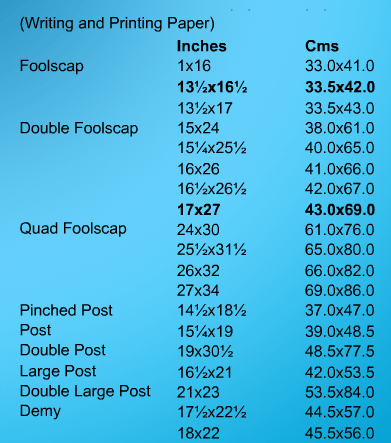
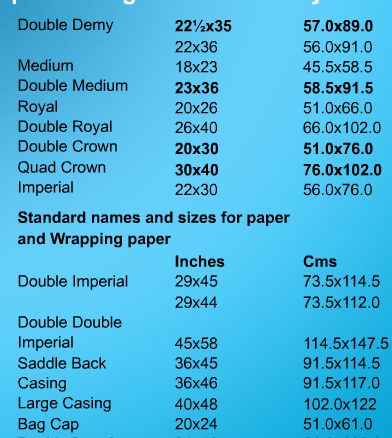
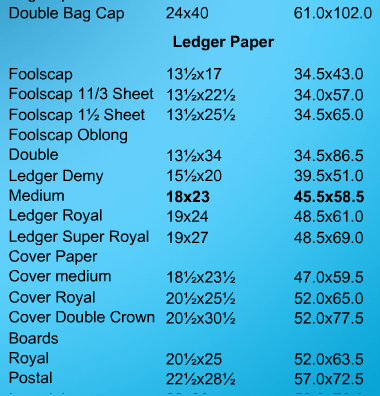

Note: Usually one ream of Writing or Printing Paper contains 500 sheets
whereas one ream of packing paper contains 480 sheets. Board comes both in
ream packing containing 500 sheets as well as Gross packing of 144 sheets or
a packet of 150 sheets. Bold indicates paper regularly available in the
Indian Market
INTERNATIONAL PAPER SIZES
International Organisation for Standardisation (ISO) have recommended standardisation of Paper Sizes and simplify manufacture, storage and marketing.
There are three series of trimmed sizes designated as A, B & C series. The basic size from which all other sizes are derived is the size AO (841x11 89mm), the superficial area of which is 1 sq. metre. Further sizes of the A series are obtained by halving the longer side of the sheet and of the resulting divisions. B & C series are geometrical intermediate forms of the A series.
The basic ISO series of trimmed series are as under:
A Series - AO =
841 x 1189 mm
B Series - BO = 1000 x 1414 mm
C Series - CO = 917 x 1297
mm
Other sizes of the ISO series are given below, the cipher, which also
indicates the number of Central folds, being added to the letter of the
series.
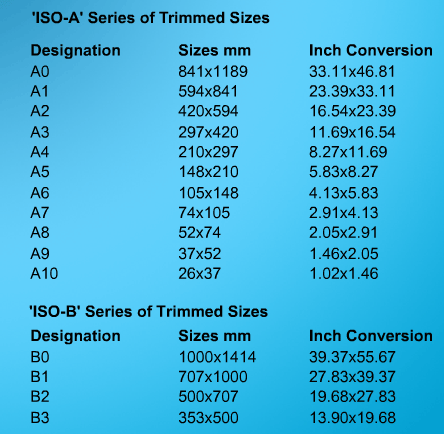
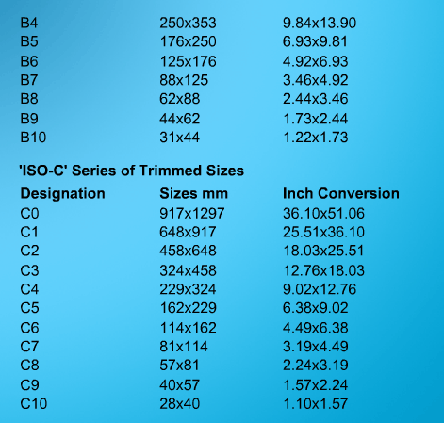
- Physical properties normally include substance, thickness, bulk density, stillness, tear, bursting and tensile strength.
- Optical properties include light transmittance, light absorption and light reflectance.
- Chemical properties include PFI, moisture content, alpha cellulose content and copper number.
- Electrical properties include dielectric strength, specific inductive capacity.
